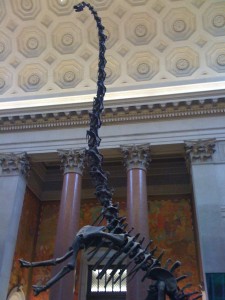Visit at AMNH (what is that?) :-)
Back from LPSC (what is that?)
April 3, 2009400 Years of the Telescope: The Film on PBS!
April 14, 2009Last week I mentioned that after attending the LPSC conference, I went to New York City to give a talk at the AMNH. The AMNH which stands for American Museum of Natural History, is a very place that most of the people which visit New York City has seen on the map and maybe took the time to visit. Located in the Upper West Side, this museum contains a large number of exhibitions about biology, evolution, meteorites, and fossils. In 2000, a new building dedicated to astronomy was opened to the public. It contains a state-to-the-art planetarium, an exhibition dedicated to astronomy, but also a department of astronomy.
It is not very common that a museum hosts a department of astronomy, generally the curators (the name of permanent positions at a museum) are biologists or meteorite specialists. With the opening of the new building, the AMNH expanded his astronomy department and hired various astronomers. My friend and colleague Orsola de Marco that I met at University College London after my master (in 1997!) was one of them. She moved recently to the Macquarie University in Sydney unfortunately. She motivated me to give a talk at the AMNH since various astronomers over there have interest in high angular resolution imaging using adaptive optics. For instance, the museum advertised my work in Oct 2008 when we released the first observation with MCAO of Jupiter (see ESO and Berkeley PRs).
After giving my talk about the Jupiter data and their analysis, I had the opportunity to meet the group led by Ben Oppenheimer. I know Ben for a long time as well, since he was a postdoc at the department of astronomy at UC-Berkeley when I arrived in the US in 2000. Ben got hired as a curator at the museum and leads a group which, to summarize, build, test at Palomar 5m-Hale telescope and do science with innovative instruments. I was very impressed by their recent project (called Project 1640) which consists of a low spectral resolution combined with high spatial and dynamic range instrument. This project is the result of combining adaptive optics system with integral field unit and coronagraphic techniques and aims at detecting exo-planets, planets orbiting around other stars. A similar instrument, called Gemini PlanetImager (GPI, pronounce it “Geee pi”) is being built for the Gemini south telescope, a 8m telescope located at Cerro Pachon in Chile. Its first light will happen in late 2010. GPI is one of the major projects in observational astronomy, and Project 1640 which is quite similar, should provide valuable technical and scientific information. Ben and myself are part of the large team which is building, will test and possibily observe with GPI in 2010. If this blog is still active by then, I will share with you the first results 🙂
Clear skies,
F.





